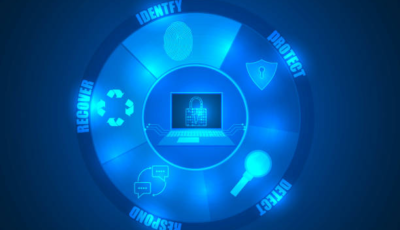NIST Risk Management Framework (RMF) is an essential process that integrates security, privacy, and cyber supply chain risk management activities into system development life cycles. Controlling organizational risks is integral for creating effective information security and privacy programs.
RMF analysis can be applied to new and legacy systems alike, any type of technology (IoT/control systems), and organizations of any size/sector, making it an incredibly versatile approach that organizations looking to secure their information systems while managing risks effectively should adopt as part of their risk mitigation strategies.
Joint Task Force’s RMF provides an approach for selecting and specifying controls based on risk considerations that take into account effectiveness, efficiency, legal constraints, and legal restraints. It plays an integral part in effectively managing organizational risks as well as developing robust security and privacy programs.
This article explores the NIST Risk Management Framework and covers the following aspects:
- What is NIST and NIST Risk Management Framework?
- What steps are involved in the NIST RMF process?
- How is third-party risk management incorporated into the NIST Framework?
- What is NIST Risk Management Framework 800-37?
- What is NIST Risk Management Framework 800-53?
Why is Astra Vulnerability Scanner the Best Scanner?
- Runs 8000+ tests with weekly updated scanner rules
- Scans behind the login page
- Scan results are vetted by security experts to ensure zero false positives
- Integrates with your CI/CD tools to help you establish DevSecOps
- A dynamic vulnerability management dashboard to manage, monitor, assign, and update vulnerabilities from one place.
- Helps you stay compliant with SOC2, ISO27001, PCI-DSS, HIPAA, etc.
- Integrates with Slack and Jira for better workflow management
- Trusted by the brands you trust like Agora, Spicejet, Muthoot, Dream11, etc.

What is NIST?
NIST (National Institute of Standards and Technology) is a federal non-regulatory agency within the Department of Commerce dedicated to creating measurement standards and technologies designed to increase productivity, facilitate trade, and enhance quality of life. NIST plays an essential role in setting IT industry standards as it has developed several cybersecurity frameworks, guidelines, and best practices, which have become widespread global best practices.
NIST works across a broad spectrum of topics – cryptography to cybersecurity to computer security to information security – developing guidelines and standards with input from various stakeholders (federal agencies, private sector organizations, and academia) to develop practical, effective standards with widespread applicability.
What is the NIST Risk Management Framework
The NIST Risk Management Framework (RMF) is an established process designed to aid organizations in managing information security and privacy risks comprehensively. This approach encompasses security, privacy, and cyber supply chain risk management activities in system development life cycles for an all-encompassing approach in an age where cyber-attacks come from various sources – both externally as well as within organizations themselves. This holistic strategy is especially vital in today’s interconnected world, where threats from third parties as well as within supply chains could cause havoc with an organization.
RMF provides organizations with several key steps for successfully planning, implementing, and continuously monitoring security and privacy controls. It focuses on adopting a risk-based approach when choosing and specifying controls; this involves identifying risks to an organization’s operations before selecting controls to minimize those risks to acceptable levels. Adopting such an approach ensures organizations utilize resources effectively in managing major risks that they face effectively and efficiently.
JTF created RMF that is highly applicable across many organizations both inside and outside the federal government – its creation serves to demonstrate this fact.
NIST Risk Management Framework Steps
The NIST Risk Management Framework (RMF) is organized into a series of steps that guide organizations through the process of managing their security and privacy risks. These steps are crucial for preparing the organization, implementing necessary controls, and ensuring continuous monitoring of risks and controls.
Step 1: Prepare
Organizations can begin the journey towards effective security and privacy risk management by first setting out to create the context and prerequisites that allow them to do so effectively. This involves setting up and maintaining the RMF, categorizing system information accordingly, assigning roles/responsibilities appropriately, etc.
Step 2: Categorize
At this step, organizations categorize both their system and the information processed, stored, or transmitted through it based on an impact analysis performed to ascertain the potential impact of a security breach on the operations of an organization and its activities.
Step 3: Select
Based on their categorization and risk analysis, organizations select security controls from NIST SP 800-53 that meet their unique organizational and system development/maintenance needs. These may also include NIST 800-53 specific controls designed to address such specific issues as cyber risk management.
Step 4: Implement
Once selected controls have been chosen and deployed, organizations must implement them while keeping detailed documentation to show compliance with any laws or regulations applicable. This documentation forms an essential element of their Risk Management Framework and must demonstrate this compliance to future steps of RMF analysis.
Step 5: Evaluate
In this step, organizations review their implemented controls to see whether or not they are in place, functioning according to plan, and producing the expected results. This evaluation process ensures that the management of risks posed by the organization is effective.
Step 6: Authorize
Following assessment, an accountable official (such as an authorizing official or senior accountable official ) makes an authorizing decision for the system based on risk analysis to allow its operation if security and privacy risks have been determined to be acceptable levels.
Step 7: Monitor
To complete this final step of ensuring effective security controls over time and to quickly respond to changing threat landscapes, organizations need to conduct ongoing surveillance of security controls and risk posture of information systems and organizations. Continuous surveillance helps keep an organization abreast of its threats as threats change over time and allows it to act appropriately when responding quickly to new challenges that emerge.
Third-Party Risk Management Framework NIST
Management of third-party risks is an integral component of an effective risk management strategy for any organization. Third parties such as vendors, suppliers, and service providers frequently have access to sensitive data and systems within an organization and thus pose potential threats that can compromise them, leading to unauthorized access, data loss, or security incidents within it – so managing such risks effectively becomes essential in protecting an enterprise from its liabilities.
The NIST Risk Management Framework (RMF) offers an effective framework to address third-party risks. Focusing on risk identification and assessment before selecting and implementing appropriate controls to address them, this approach can be applied to third-party risks by:
1. Deliberating and Assessing Risks:
The first step should be identifying third parties with access to systems or data within your organization and then assessing any associated risks – for instance, by reviewing security policies, procedures, and controls provided by them as well as potential implications a breach may pose for your organization.
2. Select and Implement Controls:
Based on a risk evaluation, selecting and implementing suitable controls to manage risks associated with each third party is key in managing any associated risks. This might involve contractual provisions requiring the third party to meet specific security standards, performing regular audits to audit the security practices of said third parties or installing technical safeguards restricting their access only when absolutely necessary systems and data require their access.
3. Monitoring and Continuous Improvement:
It is vitally important that organizations keep an eye on third-party compliance with agreed-upon controls, making any adjustments as required and updating these as per changes in either threat landscapes or operations of organizations. This may mean regular reviews of security practices by third parties as well as access monitoring with systems and data access monitoring by organizations; updates could include updating controls based on changes within an organization itself, such as organizational restructuring plans.
NIST Risk Management Framework 800-37
NIST Special Publication 800-37, “Guide for Applying the Risk Management Framework to Federal Information Systems,” is an extensive guide offering detailed instructions for applying the Risk Management Framework (RMF). While mandatory for federal information systems, private sector organizations often rely on it as best practice guidance. Not only does the document explain each step and task involved with RMF implementation, but it also offers guidance regarding the preparation of organizations/systems as well as risks/privacy management in preparation for RMF use as well as monitoring security controls/risk posture for ongoing review/monitoring purposes.
NIST SP 800-37 provides valuable guidance regarding the roles and responsibilities of various stakeholders involved in RMF implementation, such as authorizing officials, chief information officers, senior information security officers, information system owners, and common control providers – among others. Understanding their respective responsibilities for effective RMF implementation.
Additionally, this publication offers guidance on documenting RMF activities. Documentation can help demonstrate compliance with laws and regulations as well as ensure RMF activities are carried out consistently across an organization.
NIST Risk Management Framework 800-53
NIST Special Publication 800-53, “Security and Privacy Controls for Federal Information Systems and Organizations,” is one of the cornerstone documents in the NIST Risk Management Framework (RMF). This catalog of security and privacy controls helps organizations better manage risks by being easily customizable for use across any type of system – not only federal systems but any type.
This publication contains different families of controls that address different aspects of security and privacy, such as access control, audit and accountability, security assessment, and authorization, system and communications protection, system and information integrity, and system and communications protection. Each family includes controls designed to address different elements of protection; for instance, the access control family includes measures related to restricting system access only to authorized users or processes acting on their behalf (processes acting for authorized users) or devices (which include other systems).
NIST SP 800-53 provides guidance for selecting and tailoring appropriate controls to an organization’s information system based on categorization and risk evaluation to ensure they apply effective controls that address specific risks.
The document also offers guidance for assessing the effectiveness of implemented controls by providing guidance for developing assessment plans, conducting assessments, and producing evaluation reports. Proper evaluation ensures that controls have been installed effectively in managing risks within an organization and remain functional over time.
How can Astra Help You Master the NIST Risk Management Framework?
Astra is a leading provider of penetration testing services. We offer essential resources such as NIST vulnerability scanning to help organizations ensure compliance, enhance risk management, and fortify their networks against both internal and external threats.
As a trusted partner of leading organizations, we have the skills and expertise to seamlessly integrate penetration testing, vulnerability assessments, and security management into your existing processes to help you master the NIST Risk Management Framework.
Conclusion
The NIST Risk Management Framework (RMF) provides organizations with a systematic, structured method for effectively controlling the security and privacy risks they are exposed to. It integrates security, privacy, and cyber supply chain risk management activities into system development life cycle processes for new systems as well as legacy ones across any type of technology or organizational type imaginable. Key documents – NIST SP 800-37 and SP 800-53 – offer guidance in applying RMF steps effectively as well as selecting, tailoring, and assessing security and privacy controls accordingly.
Implementation of RMF includes prepping your organization, categorizing systems and information, selecting and implementing controls, assessing their effectiveness, authorizing system operation, and continuously monitoring controls and risk posture. Third-party risks must also be managed effectively, with RMF implementation proving helpful here too; furthermore, utilizing it helps organizations ensure confidentiality, integrity, and availability in information systems.
FAQs
What is the difference between NIST 800 37 and 800 53?
NIST SP 800-37 is a guide for constructing a security baseline, while NIST SP 800-53 is a regulatory standard that provides minimal control guidance for federal information systems. The former is a set of recommended security and privacy controls for federal information systems and organizations to meet the FISMA requirements.
















